|
 |
How We Played
Our days were spent doing chores and playing games. This was how we learned and how we prepared to be adults. The younger boys and girls played together.
Our toys were made from anything we could find. Twigs and sticks became horses and riders. Knuckle and wrist bones from buffalo were other horses. Boiled hooves and scraps of hide, stuffed with grass or animal hair, were dolls.
Using small bows and arrows gave us the skills for hunting and protecting our people. |
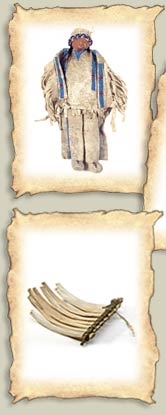 |
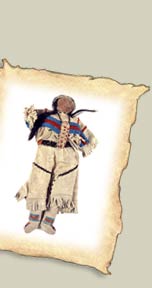 |
more images
Dolls made from fabric and hide, decorated with glass beads.
Collection of
Glenbow Museum
Dolls made from fabric and hide, decorated with glass beads.
Collection of
Glenbow Museum
Sled made from buffalo ribs. Collection of
Glenbow Museum |
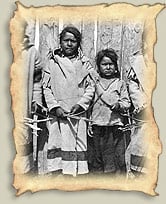 |
more images
Children with small bows and arrows
Glenbow Archives NA-1773-27 |
|
 |
|
 |
Helping Our Mothers
When we were eight or nine years of age we began to have more adult responsibilities. Girls helped their mothers tan hides, dry meat and berries, and make mookimaani (pemmican).
They also began sewing clothes and learning how to decorate them with paint and kaayiis (porcupine quills). We dyed porcupine quills and wove them into intricate patterns to decorate our clothing. This was a special skill and girls had to earn the right to use these quills. |
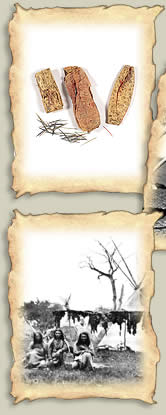 |
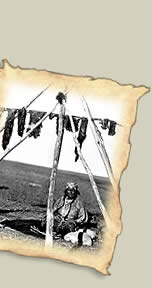 |
more images
kaayiis (porcupine quills)
Collection of
Glenbow Museum
Drying meat and berries
Glenbow Archives
NA-879-5
Drying meat and berries
Glenbow Archives NA-1463-51
|
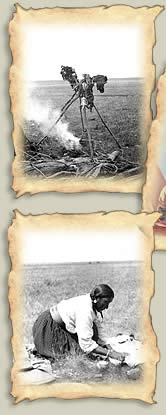 |
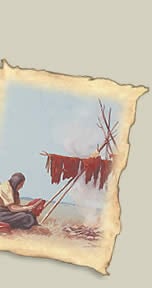 |
more images
Drying meat and berries
Glenbow Archives NA-3322-22
Gerald Tailfeathers,
Winter Meat, 1960,
Collection of Glenbow Museum
Tanning Hides
Glenbow Archives NA-5425-137
|
|
 |
|
 |
Boys' Chores
Boys would care for the horses. This meant rounding up the herd every morning and leading them to water. The animals were watched all day and all night so that no one could sneak into our camp and steal them. The boys also hunted gophers with bows and arrows or ran races and wrestled. This was good training for the skills and endurance of a warrior. |
Iksisst (aunts and uncles)
Iksisst (aunts and uncles) were responsible for disciplining those who misbehaved.
|
 |
|
 |
Mini’poka
Sometimes one child became a
mini’pokaa (favourite child or grandchild). This individual was spared from doing chores and shielded from the problems of a normal childhood. If the family was wealthy, this
mini’pokaa received elaborate gifts. Miniature tipis were made and painted with sacred designs. Some of these children became successful leaders. |
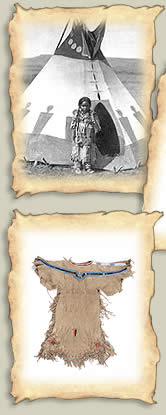 |
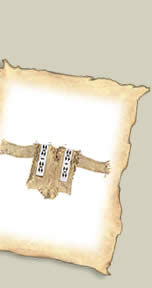 |
more images
Girl in front of her painted tipi.
Glenbow archives NA-1700-35
Boy's Shirt,
Siksika, early 1900s,
Collection of Glenbow Museum
Girl's Dress,
early 1900s,
Collection of Glenbow Museum
|
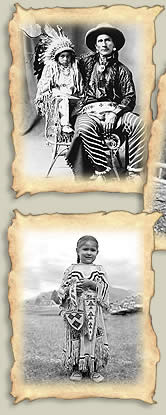 |
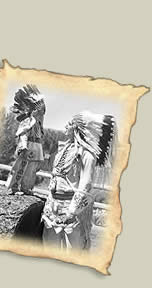 |
more images
Bobtail Chief with his grandson Billy Scout, Kainai, ca 1900.
Glenbow Archives ND-3-333
Last Star and his son.
Glenbow Archives NB-21-34 Minnie Crowfoot
Glenbow Archives NB-40-712 |
|
 |
|
 |
Older Children
Older children watched over younger ones, keeping them from danger.
|
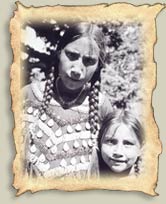 |
Glenbow Archives NA-5424-53
|
 |
|
|

